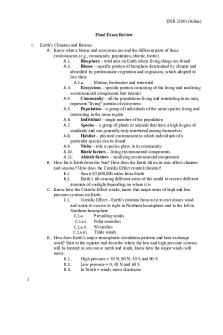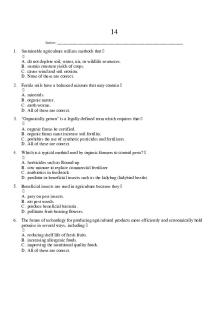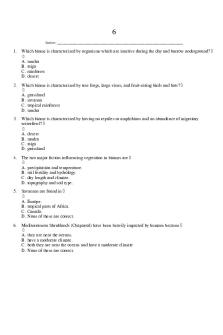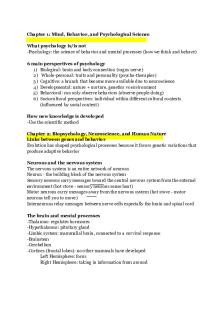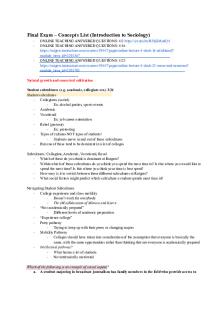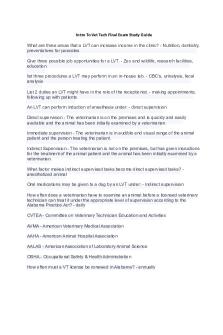Intro to Environmental Science - Final Exam Guide PDF

| Title | Intro to Environmental Science - Final Exam Guide |
|---|---|
| Course | Intro to Environmental Science |
| Institution | Ohio State University |
| Pages | 37 |
| File Size | 327.3 KB |
| File Type | |
| Total Downloads | 76 |
| Total Views | 186 |
Summary
Final Exam Guide...
Description
ENR 2100 (Online) Final Exam Review I.
1
Earth’s Climates and Biomes A. Know what a biome and ecosystem are and the different parts of these environments (e.g., community, population, abiotic, biotic). A.1. Biosphere – total area on Earth where living things are found A.2. Biome – specific portion of biosphere determined by climate and identified by predominant vegetation and organisms, which adapted to live there A.2.a. Marine, freshwater and terrestrial A.3. Ecosystem – specific portion consisting of the living and nonliving environmental components that interact A.4. Community – all the populations living and interacting in an area, represent “living” portion of ecosystem A.5. Population – a group of individuals of the same species living and interacting in the same region A.6. Individual – single member of the population A.7. Species – a group of plants or animals that have a high degree of similarity and can generally only interbreed among themselves A.8. Habitat – physical environment in which individuals of a particular species can be found A.9. Niche – role a species plays in its community A.10. Biotic factors – living environmental components A.11. Abiotic factors – nonliving environmental components B. How far is Earth from the Sun? How does the Earth tilt on its axis affect climates and seasons? How does the Coriolis Effect control climates? B.1. Sun is 93,000,000 miles from Earth B.2. Earth’s tilt causing different areas of the world to receive different amounts of sunlight depending on where it is C. Know how the Coriolis Effect works, know that major areas of high and low pressure systems on Earth. C.1. Coriolis Effect – Earth’s rotation from west to east causes wind and water to swerve to right in Northern hemisphere and to the left in Southern hemisphere C.1.a. Prevailing winds C.1.a.i. Polar easterlies C.1.a.ii. Westerlies C.1.a.iii. Trade winds D. How does Earth’s major atmospheric circulation patterns and heat exchange work? Start at the equator and describe where the low and high pressure systems will be located as you move north and south, know how the major winds will move. D.1. High pressure = 30 N, 90 N, 30 S and 90 S D.2. Low pressure = 0, 60 N and 60 S D.3. In North = winds move clockwise
ENR 2100 (Online)
E.
F.
G.
H.
2
D.4. In South = winds move counterclockwise Know Earth’s ocean circulation patterns both at the surface of the ocean and deep in the ocean. E.1. Ocean Conveyor Belt E.1.a. At equator = water wells up becoming fresher and warmer E.1.b. At North and South Poles = cold salty water sinks Know what orographic precipitation is and where you would expect it to occur on Earth. What types of organisms would you expect to find in the Rainshadow? F.1.Orographic precipitation – produced when moist air is lifted as it moves over a mountain range, falls upwind of mountain ridge F.2.Rainshadow – region having little rainfall because it is sheltered from prevailing rain-bearing winds by a range of hills Know how to read a graph that shows the upper and lower limits of a species population numbers. G.1. Bell curve with zone of optimal range in center G.2. Each organism must maintain homeostasis within itself G.3. Each species has an upper and lower limit of tolerances beyond which an organism cannot survive Know the characteristics of Earths major biomes in terms of temperature, precipitation and organisms that you would find in each. H.1. Tundra H.1.a. Treeless biome in the far north that consist of boggy plains covered by lichens and mosses H.1.b. Southern hemisphere has no tundra H.1.c. Characterized by harsh cold winters, little precipitation and short summers H.2. Boreal Forest H.2.a. Just south of tundra, cold to cool temperatures H.2.b. Southern hemisphere has no boreal forests H.2.c. Northern coniferous forest across North America and Eurasia H.2.d. Acidic, mineral poor soils, permafrost deep under soil H.2.e. Little precipitation H.3. Temperate Deciduous Forest H.3.a. Columbus, Ohio H.3.b. Deciduous hardwood trees forming dense canopy overlies saplings and shrubs H.3.c. Warm temperatures in summer months and cool temperatures in winter H.3.d. Topsoil typically rich in organic matter and deep clay-rich lower soil H.3.e. Annual precipitation ranges from 75 – 125 cm H.4. Temperate Rainforest H.4.a. Pacific northwest of North America, southeastern Australia, southern South America
ENR 2100 (Online)
H.5.
H.6.
H.7.
H.8.
3
H.4.b. Temperature fairly constant due to proximity to coast H.4.c. Winters are mild and summers are cool H.4.d. Soils have high organic content but cool temperature decrease activity to bacteria and fungi to decompose material therefore soil is nutrient poor H.4.e. High annual precipitation (200 – 380 cm) Tropical Rainforest H.5.a. Species-rich forest H.5.b. Warm temperatures year-round H.5.c. Found in Central America, South America, Africa and Southeast Asia H.5.d. Little organic matter due to high temperatures, which leads to active bacteria and fungi and detritus-feeing insects that rapidly decompose organic matter H.5.e. Annual precipitation high typically 200 – 450 cm Desert H.6.a. Lack of precipitation limits plant growth H.6.b. Temperatures relatively constant throughout year but large daily temperature changes b/c low water vapor content of air = cold nights and hot days H.6.c. Found in both temperate and tropical regions H.6.d. Soil is low in organic material but often high in mineral content, particularly salts H.6.e. Sparse plant cover H.6.f. Precipitation generally less than 25 cm per year Savanna H.7.a. Tropical grassland with widely scattered trees H.7.b. Temperatures constant throughout year H.7.c. African savanna is best known, although also found in South America, western India and northern Australia H.7.d. Nutrient-poor soil b/c heavily leached during rainy seasons H.7.e. Annual precipitation ranges from 85 – 150 cm and this is overriding climatic factor H.7.f. Precipitation occurs during rainy season followed by prolonged dry periods Temperate Grassland H.8.a. Cold winters and hot summers – large annual temperature difference H.8.b. Vegetation is grasses, trees grow sparsely except near rivers and streams H.8.c. Great Plains of USA H.8.d. Periodic wildfires help maintain grasses as dominant vegetation H.8.e. Soil has high organic matter from decomposing grass H.8.f. Annual precipitation ranges from 25 – 75 cm
ENR 2100 (Online) Mediterranean H.9.a. Mild moist winters and hot dry summers H.9.b. Vegetation is small-leafed shrubs and small trees H.9.c. Found in Santa Monic Mountains of USA and areas around Mediterranean Sea, southern Australia, central Chile, southwestern South Africa H.9.d. Little organic matter and nutrient-poor soil H.9.e. Annual precipitation low, occurs in winter months Earth’s Freshwater Resources A. Know about the connection between the Oil Sands in Alberta, Canada, freshwater resources and the Keystone Pipeline and the Ogallala Aquifer A.1. Keystone Pipeline transports synthetic crude oil and diluted bitumen from Athabasca Oil Sands in Alberta, Canada, to refineries in Illinois and Oklahoma, and on to the Gulf Coast A.2. Ogallala Aquifer provides freshwater to 8 states B. Understand what hydraulic fracturing (hydro-fracking) is and where it is occurring in the USA and Ohio. Also, know about fracking wastewater injection wells, natural gas, methane and oil. B.1. Hydro-fracking – a technique in which large amounts of water, combined with smaller amounts of chemicals and sand, are pumped under high pressure into a drilled gas well B.2. Caused earthquake in Youngstown, Ohio C. What’s the Waterkeeper Alliance? C.1. Mission: to provide a way for communities to stand up for their right to clean water and for the wise and equitable uses of water resources C.2. Robert F. Kennedy, Jr. – founder D. Where is Earth’s freshwater located (e.g., glaciers, groundwater, surface water), what is it used for and how much (e.g., agriculture, industry and cities). D.1. Only 2.5% is freshwater D.1.a. 60% in glaciers, 10% surface water, 30% groundwater D.2. 70% used for agriculture, 22% for industrial, 8% for cities/homes E. Where did Earth’s water most likely originate? How much is salt water, how much is freshwater, how much freshwater is accessible to humans? E.1. 97.5% saltwater, 2.5% freshwater F. How much water does it take to grow the food you eat each day? How much water does it take to grow 1-pound of beef or chicken or pork or other types of fruits and vegetables? F.1.Takes 1,000 gallons a day to make typical American’s diet G. What types of meat do most humans eat? How much do we consume each year? G.1. 1.7 million camels, 24 million water buffalo, 293 million cows, 396 million goats, 518 million sheep, 63 million turkeys, 1.1 billion rabbits, 1.3 billion pigs, 2.6 billion ducks, 52 billion chickens H. What are human’s staple foods, what meats do we rely on for protein? H.1. Staple foods – principle edible plants essential to people’s diets H.9.
II.
4
ENR 2100 (Online)
I.
J.
K.
L.
M.
N.
O.
5
H.2. 80,000 edible plants – 30 provide 95% of our nutrition, 8 plants provide 75% H.3. Rely on cattle, pigs, sheep, horses, poultry, mules, goats, camels and buffalo How much livestock waste is generated each year to grow the meat we eat? How much energy is required to grow 100 calories of meat versus 100 calories of vegetables? I.1. Livestock produces 900 million tons of waste annually Today, why is agriculture pollution largely regarded as public enemy #1 in the USA? What causes the algae blooms in Lake Erie? J.1. Waste from agriculture contaminates freshwater resources when runoff comes off fields J.2. Nitrogen oxides get into water which allows algae to grow, sunlight blocked, no oxygen, kills plants and organisms Do all humans have access to clean safe freshwater? K.1. No b/c less than 1/100 of 1% of water on Earth is usable by humans and most is held in glaciers K.2. About a billion people do not have access to appropriate sanitation or freshwater K.3. Both physical and economic scarcity Know the water cycle, condensation, precipitation, groundwater, and infiltration. L.1.Heat causes evaporation and transpiration L.2.Rising gases are cooled to yield another state change back to liquid; liquid water is returned to Earth to fill ground storage, underground storage, and to become available for uptake by plants L.3.At each stage, bonds are made and broken; toxins may be picked up, transported or eliminated Where is the Yellow River and what is its significance in terms of providing freshwater to who? M.1. Yellow River = China M.2. Needed by farmers but used by many industries How much water is used to grow the plants we use for food and clothes? N.1. 1 pair of jeans = 2,900 gallons N.2. Cotton shirt = 766 gallons Where is the Colorado River, what is its significance, what is the water used for, know about the Hoover Dam and salinization? O.1. Provides water for 25 million people, including cities of Denver, Las Vegas, Salt Lake City, Albuquerque, Phoenix, Los Angeles, and San Diego O.2. Hoover Dam blocks Colorado River which makes Lake Mead O.3. Supplies irrigation water for 3.5 million acres of fruit, vegetables and field crops worth $1.5 billion/year O.4. Has 49 dams, 11 of which provide hydroelectric power O.5. Water that has been withdrawn from Colorado River for agriculture has resulted in salinization of irrigated soli; because irrigated
ENR 2100 (Online)
III.
6
water soaks into arid soil and does not runoff land into rivers like would naturally occur; water has small amount of dissolved salt that remains in soil after water is used by plants and evaporated into air O.5.a. Increased salt concentration lowers soil productivity and can render soil unfit P. What is a confined aquifer, unconfined aquifer, saltwater intrusion, well, water table? P.1. Water trickling down into Earth naturally fills cracks and crevices while maintaining water table and refilling aquifer P.2. Confined aquifer – aquifer below land surface that is saturated with water, layers of impermeable material are both above and below causing it to be under pressure so that when aquifer is penetrated by well, water will rise above top of aquifer P.3. Unconfined aquifer – upper surface is open to atmosphere through permeable material, no overlying impervious rock layer to separate from atmosphere P.4. Saltwater intrusion – movement of saline water into freshwater aquifers P.5. Water table – the level below which the ground is saturated with water P.6. Well – shaft sunk into ground to obtain water Q. How does a wastewater treatment facility work, what is primary, secondary and tertiary treatment? Q.1. Primary – removes suspended and floating particles by mechanical process Q.2. Secondary – reduces water’s biochemical oxygen demand (BOD) by using microorganisms to decompose suspended organic material Q.3. Tertiary – advanced wastewater treatment methods that are sometimes employed to reduce phosphorus and nitrogen concentrations using variety of chemical, biological and physical processes R. What are some of the chemicals in our drinking water that wastewater treatment facilities do NOT remove from our drinking water? R.1. Herbicides, pesticides, pharmaceuticals and many others b/c too expensive S. How does sewage treatment work in Arcata, California? S.1.Mimics natural processes S.2.Wastewater, screen out large debris, clarifier, ponds, treatment marshes, enhancement marshes, Humbolt Bay Protecting Earth’s Freshwater A. What are some of water’s properties that make it so useful for life, what is water.org? A.1. Water molecules are polar – one end (hydrogen) is positively charged and the other end (oxygen) is negatively charged A.2. Water.org = water conservation efforts (Matt Damon) B. What is water pollution, point source pollution and nonpoint source pollution,
ENR 2100 (Online)
C.
D.
E. F. G.
runoff pollution? What are some pollutants found in our freshwater resources? B.1. Water pollution – contamination of water bodies, occurs when pollutants are discharged into water bodies without adequate treatment B.2. Point source pollution – single identifiable source B.3. Nonpoint source pollution – from diffuse sources B.4. Runoff pollution – when water drains to a common point picking up soil contaminants along the way B.5. Industrial chemicals, raw sewage, garbage, oil, pesticides, mercury, etc. Know about hypoxia, biological oxygen demand, sediment pollution. C.1. Hypoxia – deficiency in the amount of oxygen C.2. Biological oxygen demand (BOD) – indicated amount of waterdossolved oxygen consumed by microbes incubated in darknes for five days at ambient temperature, high BOD = high pollution C.3. Sediment pollution – dirt, minerals, sand and silt eroded from land and washed into water, comes from areas where there is inadequate vegetation to slow runoff Know the three zones of a freshwater lake, littoral, limnetic and profundal and their characteristics. D.1. Littoral – shallow water near shore where sunlight penetrates to permit photosynthesis D.2. Limnetic – open water as far down as sunlight penetrates to permit photosynthesis D.3. Profundal – deep water where sunlight does not penetrate, bacteria and decomposers Where is Crater Lake and what type of lake is it? E.1. Oregon; oligotrophic lake Where is Grand Lake St. Mary’s and what type of lake is it? F.1.Ohio; eutrophic lake Know the differences between oligotrophic, mesotrophic and eutrophic lake.
G.1. Oligotrophic – low nutrients (healthy) G.2. Mesotrophic – some nutrients G.3. Eutrophic – high nutrients (unhealthy) H. What do a healthy versus unhealthy Chesapeake Bay look like? Know about algae blooms, biological oxygen demand (BOD), dissolved oxygen, sunlight and photosynthesis. H.1. When oxygen increases, things go awry H.1.a. Excess nutrients begin process of eutrophication H.1.b. For many plants, limiting factors include nitrogen and phosphorus H.1.b.i. Contained in fertilizers that, when washed into waterway, provide boost to algae H.1.c. As algae flourish, light penetration is reduced, submerged aquatic plants can no longer photosynthesize and oxygen levels 7
ENR 2100 (Online)
I.
J. K.
L.
M.
N.
O.
P.
Q.
8
drop H.1.d. As algae die, decomposers increase, BOD increases and dissolved oxygen levels drop more Where is Bristol Bay, what is the Pebble Mine and how will it affect the fishing industry, ecosystem, economy. I.1. Alaska; Pebble Mine is copper and gold mine I.2. Could cause pollutants in Bay which would kill fish and ecosystem Know about algae blooms and excess nitrogen and phosphorus. J.1. Excess nitrogen and phosphorus allows algae blooms to grow What dissolved oxygen concentrations do fish prefer to live in? K.1. Less than 3.0 ppm = too low for fish populations K.2. 3.0 – 5.0 ppm = stressful, cannot survive more than 12 – 24 hours K.3. 6.0 ppm = supports spawning K.4. 7.0 ppm = supports growth/activity K.5. 9.0 ppm = supports abundant fish population What is a watershed? L.1.Area or ridge of land that separates waters flowing to different rives, basins or seas What are the leading causes of water pollution in the USA today? M.1. Pathogens, metals, nutrients, hypoxia, PCBs, sediments, mercury, pH problems, and pesticides Provide examples of point source pollution and nonpoint source pollution. Which one does the Environmental Protection Agency (EPA) regulate using the U.S. Clean Water Act? N.1. Point source pollution – sewage treatment plant overflow, animal feedlot and waste lagoon, industrial waste discharged into water N.2. Nonpoint source pollution – open mines, industrial air pollution from smoke stacks, cropland animal pasture, construction sites N.3. Clean Water Act – mostly point source but amendment added in 1987 to address nonpoint source (runoff) What are some examples of nonpoint source runoff pollution in urban, mining, forestry and agriculture areas? O.1. Urban – waste in street gutters, lawn chemicals, household chemicals, car chemicals, soil erosion, septic system O.2. Mining – acid mine drainage O.3. Forestry – logging and erosion control O.4. Agriculture – animal waste, pesticides, soil erosion, grazing What causes the dead zone in the Gulf of Mexico, what River is involved, what type of damage does this pollution cause in terms of ecosystem and economy of the Gulf region? P.1. Hypoxic area (not enough oxygen), most organisms cannot survive P.2. Mississippi River How is Seattle, Washington trying to protect its freshwater resources and the Puget Sound? Q.1. Sampling for pollutants and determining origin
ENR 2100 (Online) R. How much nitrogen pollution is released by forested, suburban and agriculture land? R.1. Forested – very little b/c trees R.2. Suburban – 25% of nitrogen that enters leaves as runoff R.3. Agriculture – about 23% of what enters becomes runoff S. How is the Cuyahoga River and the Clean Water Act tied together in history? S.1.Cuyahoga River = burned b/c so much pollution and led to need for regulation T. What is the Clean Water Act, when was it passed, what does it do, who oversees this law? Are most water resources in the USA safe for people today? T.1. Passed in 1972 established pollution standards and set into motion establishment of best management practices to reduce pollution T.2. Basic goals T.2.a. Eliminate the discharge of pollutants in US waterways T.2.b. Attain water quality levels that make these waterways safe to fish and swim in T.3. 39% nation’s rivers, 45% of lakes and 51% estuaries = too polluted U. Know about riparian areas how they work. U.1. Buffer zones that slow runoff and give rainwater time to soak into ground V. How can farms reduce the amount of runoff pollution by having different zones designated for different types of vegetation and uses? V.1. Upland area used for agric...
Similar Free PDFs

Intro To Psych Final Exam
- 24 Pages
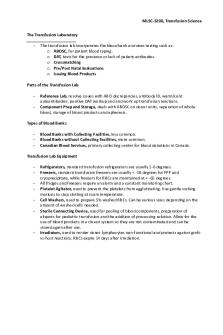
Intro to Transfusion Science
- 3 Pages

Environmental Science
- 16 Pages
Popular Institutions
- Tinajero National High School - Annex
- Politeknik Caltex Riau
- Yokohama City University
- SGT University
- University of Al-Qadisiyah
- Divine Word College of Vigan
- Techniek College Rotterdam
- Universidade de Santiago
- Universiti Teknologi MARA Cawangan Johor Kampus Pasir Gudang
- Poltekkes Kemenkes Yogyakarta
- Baguio City National High School
- Colegio san marcos
- preparatoria uno
- Centro de Bachillerato Tecnológico Industrial y de Servicios No. 107
- Dalian Maritime University
- Quang Trung Secondary School
- Colegio Tecnológico en Informática
- Corporación Regional de Educación Superior
- Grupo CEDVA
- Dar Al Uloom University
- Centro de Estudios Preuniversitarios de la Universidad Nacional de Ingeniería
- 上智大学
- Aakash International School, Nuna Majara
- San Felipe Neri Catholic School
- Kang Chiao International School - New Taipei City
- Misamis Occidental National High School
- Institución Educativa Escuela Normal Juan Ladrilleros
- Kolehiyo ng Pantukan
- Batanes State College
- Instituto Continental
- Sekolah Menengah Kejuruan Kesehatan Kaltara (Tarakan)
- Colegio de La Inmaculada Concepcion - Cebu
